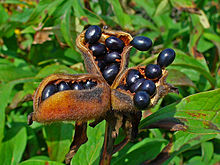Peonies
| Peonies | ||||||||||||
|---|---|---|---|---|---|---|---|---|---|---|---|---|

Shrub Peony ( Paeonia × suffruticosa ) Dianjiang (Central China) |
||||||||||||
| Systematics | ||||||||||||
|
||||||||||||
| Scientific name of the family | ||||||||||||
| Paeoniaceae | ||||||||||||
| Raf. | ||||||||||||
| Scientific name of the genus | ||||||||||||
| Paeonia | ||||||||||||
| L. |
The peonies ( Paeonia ), also called peonies , are the only genus of the peony family (Paeoniaceae). This genus includes 32 species . The best-known varieties are perennials , i.e. perennial herbaceous plants whose above-ground shoots die off in winter; and there are also woody species and varieties, mostly as a half-shrubs , less often than shrubs grow. The starting forms of the cultivars are almost always horticultural cultivations of the common peony and the milk white peony . In contrast, few garden forms are based on interspecific hybrids .
description
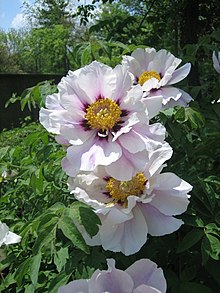


Vegetative parts of plants
Peonies are mostly perennial herbaceous plants , rare woody subshrubs , or small shrubs .
The small group of semi- shrubby Chinese species, known as "shrub" or "tree peonies", form up to 2.5 meters long stem axes that lignify. All Paeonia species and varieties are deciduous. As survival organs, they form long-lived, rather woody rhizomes with thickened roots. The seeds germinate hypogeaically .
The alternate arranged leaves are mostly relatively large and stalked. The composite leaf blade is usually with the exception of the aforementioned two types of double-ternate . The number of sections of the lower leaves vary in the perennial species between 9 ( Paeonia daurica ), 10 to 22 ( Paeonia mascula ), 78 to 91 ( Paeonia intermedia ) and 134 to 340 ( Paeonia tenuifolia ). In Paeonia intermedia and Paeonia tenuifolia , the leaves are feather-like with numerous linear leaf sections. The leaflets usually have a serrated edge or are lobed . Stipules are missing.
Flowers, fruits and seeds
The terminal flowers are about one to six bracts (bracts). They are tall and look a bit like rose petals. The hermaphrodite flowers vary greatly in the number of their flower organs. There are two to nine sepals and four to thirteen petals available. The petals usually have pink or red tones, but there are also species with white and yellow petals. In the middle of the flower there are many (up to 230), centrifugally propagated , short stamens . The stamens almost cover the two to five (up to eight) large, free carpels , which at the bottom form a disc that serves as a nectarium , the "discus". The peonies' flowers give off an intense scent .
The varieties of the shrub and tree peonies have the largest and most magnificent flowers of all peonies. They are mostly double, sometimes up to over 20 centimeters in size and have ruffled or ruffled petals.
There are pomes formed. The dark seeds are relatively large with a diameter of up to 1.3 centimeters.
Microscopic features, ingredients and chromosome number
Anatomical features of the peonies are scattered secretory cells in the parenchyma of the shoot, cortical vascular bundles with pits or ladder vessels , circular vascular bundles of the petioles, a cuticle made of wax tubules , these predominantly of palmiton ( ketone of palmitic acid ), and single-celled hairs ( trichomes ).
The basic chromosome number is x = 5. The chromosomes are 10 to 15 µm in length.
Ingredients are iridoids , essential oils , flavones and, as with all Saxifragales, myricetin and tannins .

Occurrence
With the exception of two species native to the west coast of North America , all peonies are distributed from the temperate climates and subtropical climates of Eurasia . However, some species also thrive in more continental areas of Siberia and East Asia ( Paeonia anomala , Paeonia lactiflora , Paeonia obovata ). The main distribution areas are the subtropical mountain regions in Southern Europe , Asia Minor , the Caucasus and East Asia.
Most peony species need a cold rest period in winter to be able to develop flower buds. Young leaves and flower buds, on the other hand, can be damaged by late frosts. This is especially true for the shrub peonies, which sprout particularly early.
Peonies grow mainly in mountain forests, some species are also found in the steppe regions of Eastern Europe and Asia (for example Paeonia tenuifolia ). The European peonies are found predominantly on calcareous soils and mostly grow in less closed forests and scrub forest regions. The common peony ( Paeonia officinalis ) is also more common in subalpine lawn communities in the southern Alps.
The common peony, which comes from the mountainous regions of southern Europe, is considered naturalized in places in Bavaria , especially in Franconia . Due to their long history of cultivation in Central Europe, they would be attributed to the archaeophytes that were carried away by ethelochor .
Most European peony species are only known from a few localities and therefore belong to the endangered species.
Systematics
Origin of name
The genus Paeonia was first published in 1753 by Carl von Linné in Species Plantarum . The botanical genus name Paeonia is derived from the Greek word " paionia ", which stands for Paian , the doctor of the gods . The Greek legend after he healed with the help of this plant Pluton , the god of the underworld after Heracles these in the war for Pylos had wounded. The ancient Roman poets also have similar things to say about the plant. Virgil says in the seventh song of the Aeneid that the goddess Artemis to Virbios that the horses of his father Theseus , with the help of a peony raised had been killed back to life.
External system
In the course of time, the peony plants were settled in different places in the family tree of the Bedecktsamer : Cronquist placed them in the basal order Dilleniales of the Dilleniidae (see Schmeil-Fitschen systematics ), among other things because of the centrifugal reproduction ( dédoublement ) of the stamens ; Tachtadschjan saw a close relationship with Glaucidium palmatum , which APG II classifies as a buttercup family , put Paeonia and Glaucidium each in their own order Paeoniales and Glaucidiales and assigned both to the subclass Ranunculidae (see systematics of bedecksamer ) .
The latest Angiosperm Phylogeny Group (APG iv) finally, after its scheme, the German-language Wikipedia directed that pays the peony plants to order saxifrage-like (Saxifragales) (see systematics of angiosperms ).
Common Peony ( Paeonia officinalis )
Balearic Peony ( Paeonia cambessedesii )
Yellow Caucasus Peony ( Paeonia daurica subsp. Mlokosewitschii )
The fine-leaved peony ( Paeonia tenuifolia ) is still not one of the common garden plants in Central Europe.
Internal system
The genus Paeonia contains 32 species, which can be divided into three sections:
| Surname | Common name / synonym | distribution | image |
|---|---|---|---|
| Section Moutan DC. | Shrubby peonies | ||
| Paeonia cathayana D.Y.Hong & KYPan | It occurs in the Chinese provinces of Henan and Hubei . | ||
| Paeonia decomposita Hand.-Mazz. | The two subspecies occur only in northwest Sichuan : | ||
|
Paeonia decomposita Hand.-Mazz. subsp. decomposita |
This endemic thrives only in the Dadu He Valley at altitudes of 2000 to 3100 meters in northwest Sichuan. | ||
|
Paeonia decomposita subsp. rotundiloba D.Y. Hong |
This endemic only thrives in the Min Jiang Valley at altitudes of 2000 to 3100 meters in northwestern Sichuan. | ||
| Paeonia delavayi Franch. | Delavay's shrub peony , Syn .: Paeonia lutea Delavay ex Franch. | It occurs in southeastern Tibet and in the Chinese provinces of western Sichuan and central and northern Yunnan . |
 
|
| Paeonia jishanensis T.Hong & WZZhao | It occurs in the Chinese provinces of Henan , Shaanxi and Shanxi . | ||
| Paeonia ludlowii ( Stern & G.Taylor ) DYHong | It occurs in southeastern Tibet at altitudes of 2900 to 3500 meters. |

|
|
| Paeonia ostii T.Hong & JXZhang | Syn .: Paeonia suffruticosa subsp. yinpingmudan D.Y.Hong , KYPan & Zhang W.Xie | The homeland is western Henan . |

|
| Paeonia qiui Y.L.Pei & DYHong | The homeland is western Henan and western Hubei. | ||
| Paeonia rockii ( SGHaw & LALauener ) T.Hong & JJLi ex DYHong | It occurs in the Chinese provinces of Gansu , Henan , Hubei and Shaanxi . With the subspecies: |

|
|
|
Paeonia rockii subsp. atava ( Brühl ) DYHong & KYPan |
Syn .: Paeonia rockii subsp. taibaishanica D.Y.Hong | ||
|
Paeonia rockii subsp. rockii |
Syn .: Paeonia rockii subsp. linyanshanii ( Halda ) T.Hong & GLOsti |
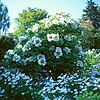
|
|
| The cultural hybrid also belongs to this section | |||
| Paeonia × suffruticosa Andrews | Shrub peony which includes the cultivated shrub peonies derived from crosses of several wild species. |
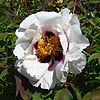
|
|
| Section Onaepia Lindl. | North American Perennial Peonies | ||
| Paeonia brownii Douglas | It occurs in the western US states of Washington, Oregon, Wyoming, Montana, Utah, Nevada, Idaho and California. |

|
|
| Paeonia californica Nutt. | Californian peony | It occurs in California and the Mexican state of Baja California . |

|
| Section Paeonia DC | Eurasian perennial peonies | ||
| Paeonia algeriensis Chabert | Syn .: Paeonia mascula subsp. atlantica (Coss.) Greuter & Burdet | It occurs in Algeria. | |
| Paeonia anomala L. | with subspecies: | Homeland China, Russia (also in the European part), Siberia, Central Asia, Mongolia | |
|
Paeonia anomala L. subsp. anomala |

|
||
|
Paeonia anomala subsp. veitchii (Lynch) DYHong & KYPan |
Syn .: Paeonia veitchii ( Lynch ) Veitch's peony | The home is China. |

|
| Paeonia arietina G.Anderson | Syn .: Paeonia mascula subsp. arietina ( G.Anderson Cullen & Heywood ), Turkish peony |
 |
|
| Paeonia broteri Boiss. & Reuter | Syn .: Paeonia lusitanica Mill. | It occurs on the Iberian Peninsula. |

|
| Paeonia cambessedesii (Will.) Will. | Balearic Peony | It only occurs in the Balearic Islands . |

|
| Paeonia clusii ( Stern & Stearn ) | Clusius peony |

|
|
| Paeonia clusii subsp. clusii | Homeland Crete , Karpathos . |

|
|
| Paeonia clusii subsp. rhodia (Stearn) Tzanoud. | Home of Rhodes . | ||
| Paeonia coriacea Boiss. | It occurs in Morocco, Spain, Sardinia and Corsica. |

|
|
| Paeonia corsica Sieber ex exchange | It occurs in Sardinia, Corsica and Greece. |

|
|
| Paeonia daurica Andrews | Crimean peony |

|
|
| Paeonia daurica subsp. daurica |
Crimean peony |

|
|
|
Paeonia daurica subsp. coriifolia ( Rupr. ) DYHong |
West Caucasian Peony |

|
|
|
Paeonia daurica subsp. macrophylla ( Albov ) DYHong |
Syn .: Paeonia macrophylla (Albov) Lomakin large-leaved peony |

|
|
|
Paeonia daurica subsp. mlokosewitschii ( Lomakin ) DYHong |
Syn .: P. mlokosewitschii Lomakin Yellow Caucasus Peony | It occurs in Azerbaijan, Georgia and southern European Russia. |

|
|
Paeonia daurica subsp. tomentosa ( Lomakin ) DYHong |
Syn .: Paeonia tomentosa (Lomakin) N.Busch |

|
|
|
Paeonia daurica subsp. velebitensis D.Y.Hong |
This endemic only thrives in the Velebit Mountains in Croatia . |

|
|
|
Paeonia daurica subsp. wittmanniana ( Hartwiss ex Lindl. ) DYHong |
Syn .: Paeonia wittmanniana Hartwiss ex Lindl. Wittmann's peony | It occurs in the Caucasus as well as in Turkey. |

|
| Paeonia emodi Wall ex Royle | It occurs in northern Pakistan, northwestern India, Kashmir, western Nepal and southern Xizang . |

|
|
| Paeonia intermedia C.A. Mey. | Syn .: Paeonia anomala subsp. intermedia ( CAMey. ) Trautv. | It occurs in Kazakhstan, Uzbekistan, Tajikistan, Kyrgyzstan, southwestern Siberia and the Chinese province of Xinjiang . | |
| Paeonia kesrouanensis ( J. Thiébaut ) J.Thiébaut | It was described from the area of Syria and Lebanon, but is also referred to by some authors as the subspecies Paeonia mascula subsp. kesrouanensis (J. Thiébaut) Halda viewed. | ||
| Paeonia lactiflora Pall. | Milky white peony Their hybrids are also known as Chinese peony or precious peony | Spreading China (Manchuria), Mongolia, Japan, Korea. |

|
| Paeonia mairei H.Lév. | It occurs in the Chinese provinces of Gansu, Guizhou, Hubei, Shaanxi, Sichuan and Yunnan . |
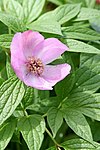
|
|
| Paeonia mascula ( L. Mill. ) | Coral peony with the following subspecies: |

|
|
|
Paeonia mascula subsp. bodurii N. Özhatay |
|||
|
Paeonia mascula subsp. hellenica Tzanoud. |
|||
|
Paeonia mascula subsp. mascula |
|||
|
Paeonia mascula subsp. russoi ( biv. ) Cullen & Heywood |

|
||
| Paeonia obovata Maxim. | There are two subspecies: | Home: East Asia |

|
|
Paeonia obovata subsp. obovata |
Syn .: Paeonia japonica ( Makino ) Miyabe & H.Takeda | ||
|
Paeonia obovata var. Glabra Makino |
|||
|
Paeonia obovata subsp. japonica (Makino) Halda |
|||
|
Paeonia obovata var. Japonica Makino , Paeonia oreogeton S.Moore |
It is common in China, Japan, Korea, and Russia's Far East . | ||
|
Paeonia obovata subsp. willmottiae ( Stapf ) DYHong & KYPan |
Syn .: Paeonia willmottiae Stapf , Paeonia obovata var. Willmottiae (Stapf) star | It thrives in deciduous deciduous forests at altitudes of 800 to 2800 meters in the Chinese provinces of southeastern Gansu, western Henan, western Hubei, southern Ningxia, eastern Qinghai, southern Shaanxi, Shanxi, eastern and northern Sichuan. |

|
| Paeonia officinalis L. | Common peony the following subspecies: |

|
|
|
Paeonia officinalis subsp. banatica ( Rochel ) Soó |
Hungary, Romania and the former Yugoslavia |

|
|
|
Paeonia officinalis subsp. huthii Soldano |
|||
|
Paeonia officinalis subsp. italica Passalacqua & Bernardo |
|
||
|
Paeonia officinalis subsp. microcarpa ( Boiss. & Reut. ) Nym. |

|
||
|
Paeonia officinalis subsp. officinalis |
|||
| Paeonia parnassica Tzanoud. | It only occurs in Greece. |
|
|
| Paeonia peregrina Mill. | Foreign peony | Their home is southern and southeastern Europe and Turkey. |

|
| Paeonia saueri D.Y.Hong , XQWang & DMZhang | It occurs on the Balkan Peninsula. | ||
| Paeonia sterniana H.R. Fletcher | It thrives only in southeastern Tibet at altitudes of 2800 to 3500 meters . | ||
| Paeonia tenuifolia L. | Fine-leaved peony | Her home is south-east Europe and southern Russia . |

|
Web links to images:
- ^ L Fig. By Paeonia decomposita
- ↑ Fig. By Paeonia jishanensis
- ↑ Fig. By Paeonia qiui
- ↑ Fig. By Paeonia algeriensis
- ↑ http://www.paeonia.ch/reiseninternet/turkey/turkbilder_7.htm ( page no longer available , search in web archives ) Info: The link was automatically marked as defective. Please check the link according to the instructions and then remove this notice. Fig of Paeonia algeriensis
- ↑ orchid-nord.com Fig. Of "Paeonia clusii" ssp. "rhodia"
- ↑ Pictures of Paeonia intermedia on Plantarium.ru (Latin + Russian)
- ↑ botany.cz Fig. By Paeonia kesrouanensis
- ↑ dogalhayat.org Fig. From `` Paeonia mascula '' subsp. '' bodurii ''
- ↑ greekflora.gr Fig. From `` Paeonia mascula '' subsp. '' hellenica ''
- ↑ dogalhayat.org Fig. From `` Paeonia mascula '' subsp. '' mascula ''
- ↑ florealpes.com Fig. From `` Paeonia officinalis '' subsp. '' huthii ''
- ↑ floraitaliae.actaplantarum.org Fig. From `` Paeonia officinalis '' subsp. '' italica ''
- ↑ naturamediterraneo.com Fig. From `` Paeonia officinalis '' subsp. '' italica ''
- ↑ naturamediterraneo.com Fig. From `` Paeonia officinalis '' subsp. '' italica ''
- ↑ greekflora.gr Fig. From `` Paeonia parnassica ''
- ↑ Archived copy ( memento of the original from January 27, 2018 in the Internet Archive ) Info: The archive link was inserted automatically and has not yet been checked. Please check the original and archive link according to the instructions and then remove this notice. Fig. Of '' Paeonia parnassica ''
- ↑ greekmountainflora.info Fig. From `` Paeonia saueri ''
use
Peonies in the garden
Cultural forms
Many varieties of two species from this genus are cultivated very frequently in Central Europe: The common peony ( Paeonia officinalis ) is also known as the real peony or peasant peony because it is an integral part of the traditional cottage garden . This species can still be found in many Central European gardens, where it will delight plant lovers with its large flowers from May onwards. As an ornamental plant for parks and gardens, however, it has increasingly faced competition from the breeding varieties of the milk white peony ( Paeonia lactiflora ) from East Asia . A total of 3,000 varieties of this genus were bred. Shrub or tree peonies are only cultivated in climatically favorable regions. Shrub peonies shed their leaves in autumn. In contrast to those of the perennial peonies, their woody shoots do not wither. Only after the Second World War did breeders succeed in crossing shrub peonies and perennial peonies successfully. The first six varieties of these crosses were named after the breeder Itoh hybrids, the term "intersectional peonies" is now more common. Common characteristics of these hybrids are the foliage and the flowers (especially the yellow color) resemble the shrub peonies, combined with the annual new growth as a perennial.

History of the peonies as a garden plant
Peonies in China

The peonies have been cultivated as an ornamental plant in Chinese horticulture for more than a thousand years. The shrub peony ( Paeonia × suffruticosa ) is native to northwest China, Tibet and Bhutan and grows there in bamboo thickets, in the undergrowth of the forests and in meadows. Chinese gardeners had already bred a range of different varieties with flower colors from white to yellow to black-violet from the originally red-flowered species when Europeans brought the first living plants to England towards the end of the 18th century. In 1834, the Royal Horticultural Society sent the plant collector Robert Fortune to China in order to purchase other peony varieties.
A second species, the milk white peony ( Paeonia lactiflora ), has been valued as an ornamental plant in China for over 1,000 years . Already at the time of the Song dynasty (961 to 1278), species 39 had been bred different varieties, which were characterized above all by densely filled, ball-like flowers.
Peonies in Europe
The peony was already known as a garden plant in European antiquity. Two of the species that are native to the Mediterranean region, the coral peony ( Paeonia mascula ) and the common peony ( Paeonia officinalis ), were already cultivated in the Mediterranean region in ancient times. Both species had a reputation for being medicinal plants. It was above all the Benedictine monks who brought the common peony from across the Alps to Central Europe in order to cultivate it as a medicinal plant in their monasteries. This is why the common peony was sometimes also referred to as the Benedictine rose. From the monastery gardens it came to the cottage gardens, where, in addition to its medicinal properties, it was also valued for its modesty and longevity.
The fact that the peonies appear in the painting Paradiesgärtlein from around 1410 is interpreted by authors such as Heinz-Dieter Krausch to mean that as early as the end of the Middle Ages they were viewed not only as a medicinal plant, but also as an ornamental plant. A peony can also be discovered in a painting by Martin Schongauer from 1473 , the picture Maria im Rosenhag , as well as in the picture of the Stuppach Madonna by Matthias Grünewald (1514–1516). In the 16th century, peonies were already widespread in gardens, and the peony was considered the "royal flower". The two types of peonies that came to Central Europe from the Mediterranean were categorized curiously by botanists at the time. The common peony was considered to be the female flower and the coral peony was the male plant. In 1561, the Zurich doctor and naturalist Conrad Gessner first mentioned the double peonies of the common peony ( Paeonia officinalis ). These spread so quickly that as early as the early 19th century Friedrich Gottlob Hayne was able to establish that the unfilled species is rarely found in gardens. In the second half of the 16th century, at least one other species of peony, Paeonia peregrina, was cultivated. The Hortus Eystettensis knew a total of eleven different varieties of the three species.
In 1757 the Botanical Garden in Göttingen first mentioned the fine-leaved peony , which had apparently been obtained from the Botanical Garden in Saint Petersburg . It was given to other botanical gardens from Göttingen and was also offered as an ornamental plant by a Hamburg nursery in 1779. To this day, it has remained a plant that is seldom cared for in gardens, as it is more sensitive to cold than its sister species.
In Lorsch, as part of the 1250th anniversary of Lorsch Abbey and in view of the Lorsch Pharmacopoeia published in 795, a public peony garden (Lorsch Peony Park) is being created. An annual peony market is also to be set up in the city.
Garden culture

The common peony ( Paeonia officinalis ) in particular is a relatively robust garden plant and this also applies to many of the cultivars of the Chinese peony. The other species place higher demands on their location and can damage leaves and shoots, especially through late frosts. It makes sense to leave peonies in one location for as long as possible, as the number of flowers increases from year to year. Peonies can thrive in the same place for decades without ever having to be excavated and divided. It is advisable to provide the plants with organic fertilizers such as bone meal or horn shavings in the spring before budding and after flowering in summer so that the plants retain their willingness to flower. Peonies occasionally respond to mineral fertilizers with yellow leaves and poor growth. It also helps the plant to bloom when cut off blooms, as the seed formation costs the plant a lot of strength, which is at the expense of the bloom set in the next year.
Peonies thrive best in a somewhat sheltered location in full or slightly filtered sunlight and in a nutrient-rich and well-drained garden soil such as loose clay soil. Peonies are so-called heavy eaters , which means that they need nutrient-rich soil. Most gardeners have found it useful to mulch them after they have sprouted and fertilize them with well-rotted manure.
Perennial peonies are planted so deep that their rhizome is about three to four centimeters below the surface of the earth. The ideal planting time is usually autumn, when the selection of varieties in the gardening trade is usually the largest. This is also the best time to plant shrub peonies. However, they are planted so deep that the grafting point is about 10 to 15 centimeters below the surface. The planting distance should be 80 to 100 cm.
Shrub peonies stand best alone or in company with other shrubs. Ideal companion plants to the perennial peonies are, for example , lady 's mantle , catnip or the species and varieties of cranesbills .
Peonies in medicine
Theophrast , Pliny and Dioscorides already refer to the medicinal properties of the peony, referring to both the coral and the common peony. However, there were certain rules to be observed when collecting the plants, which Otto Brunfels, born in 1488, summarized as follows:
- And if Pliny, like Theophrastus, speaks, when they want to dig this root, it must happen at night, due to some dangers that they should have faced during the day, because of the woodpecker , called Pici Martii, which stings people when it is bright eyes off. (Quoted from Gallwitz, p. 196f)
The reputation of the medicinal properties of peonies was maintained from antiquity until the 19th century, when the drug Radix Paeoniae was removed from the pharmacopoeias around 1860. In the Middle Ages it was considered an effective remedy for gout, it was supposed to help with children's and women's diseases.
Hildegard von Bingen wrote about the peony in her Physica;
- The paeonie (beonia, dactylosa) is fire-colored and has a good effect. It helps against the three-day as well as the four-day fever ... If a person loses his mind, as if he knew nothing and was, as it were, in ecstasy, dip peony seeds in honey and put them on his tongue, then the powers of peony increase in his Brain up and excite him so that he can quickly regain his sanity ... But also take peony seeds and dip them in the blood of a leech and then wrap the foul-smelling seeds in a dough of wheat flour and if someone falls from epilepsy, put them in his mouth while he is lying there, and do so whenever he falls from this disease and finally he will be cured. (Quoted from Krausch , p. 323)
The peony was used as a remedy for epilepsy well into the 19th century. The folk medicine also used the smoke from the seeds for the treatment of "possessed". Folk medicine knew another use of the peony: its seeds were strung on chains and given to teething toddlers to chew. In Bavaria, the seeds were therefore also called Apollonia grains - in honor of Saint Apollonia , the patroness of those suffering from teeth. In homeopathy , Paeonia is used for hemorrhoids and anal fissures , the pain of which lasts particularly long after a bowel movement.
In China, peonies (cultivar 'Fen Dan Bai', hybrid of Paeonia ostii ) are grown on a large scale for the extraction of Mudan pi, an important substance in Chinese medicine. In Europe, too, the pharmaceutical industry imports considerable amounts of peony roots, which come from natural locations in Eastern Europe and the Near East.
The flowers contain the anthocyanin dye peonidin , a methyl ether of cyanidine .
symbolism
Because of their long history of cultivation, peonies are assigned a high symbolic content. Peonies already appear in the medieval panel paintings, since they symbolized wealth, salvation, healing and beauty in the Christian symbolic language.
In Chinese garden art , peony symbolizes wealth, a pledge of love, a woman's life filled with love and the meekness of Buddha.
A Japanese proverb says:
- 立 て ば 芍 薬 、 座 れ ば 牡丹 、 歩 く 姿 は 百合 の 花
- tateba shakuyaku, suwareba botan, aruku sugata wa yuru no hana
- Standing like a Chinese peony, sitting like a shrub peony, and the way it walks, the flower of a lily .
The proverb describes the three different ideals of beauty that a woman should conform to: When standing, she should resemble a Chinese peony, with its strong stem and full bloom. On the other hand, when it sits, it should appear fragile like the shrub peony. And when it goes, it should be graceful like a lily.
In China , the peony is a symbol of nobility and wealth. One of the central works of Chinese literature is the drama The Peony Pavilion, which has been performed and edited many times . In the classical erotic literature of China, the flower name “牡丹” (pronunciation "mu-dan") is often used as an allusion to the genitals, since the character “牡” (pronunciation "mu") is etymologically related to the character “牝” (pronunciation " pin ") and was originally used to denote an ox / rooster as the opposite of a cow / chicken. In a Chinese legend, the young heroine is known by the name “白牡丹” (pronunciation "bai-mu-dan", literal translation "white peony"; namely a female person from the bai family or the "white" family with the first name) mu-dan or "peony"). This figure is namely the lover of the immortal “ 吕洞宾 ” (pronounced "lü-dong-bin") in Chinese mythology.
Peonies in art
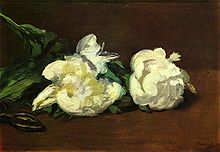
The peony is very often depicted in Chinese art, but it also plays a major role in European art. One of the first paintings in which peonies can be discovered is Das Paradiesgärtlein , which was created around 1410 by an unknown Upper Rhine master. Today this picture is one of the main works owned by the Städel Art Institute in Frankfurt . The so-called "Marienblume", as the peony was also called, is shown in the middle of the lower third of the picture. Not far from there lies the little dragon, which symbolizes disaster and thus forms the counterpart to this flower, which symbolizes salvation.
Recent artists who have chosen the peony as their motif include Édouard Manet , Auguste Delacroix and Pierre-Auguste Renoir .
The peony in literature
The poet Ferdinand von Saar dedicated a poem to the peony, which is also entitled " Peony ".
The peony in astronomy
The asteroid (1061) Paeonia is named after her.
literature
- Ivo Pauwels, Guy Vervoort, Barbara Janssens (among others): Pioenen. In full glory . Lannoo, Tielt / Warnsveld 2006, ISBN 90-209-6507-7 .
- Pamela McGeorge, Russell McGeorge: Peonies . Firefly Books, Richmond Hill, Ont. 2006, ISBN 1-55407-168-2 .
- Rock Giguère: Les pivoines . Éditions de l'Homme, Montréal 2006, ISBN 2-7619-2224-7 .
- Will McLewin, Dezhong Chen: Peony rockii and Gansu Mudan . Wellesley-Cambridge, Wellesley, Massachusetts / Stockport 2006, ISBN 0-9614088-3-9 .
- Cheng Fangyun: Chinese Flare Mudan . 2005, ISBN 7-5038-3968-6 .
- Li Jiajue (Ed.): Chinese Tree Peony Cultivar Groups . China Forestry Publishing House, Beijing 2005, ISBN 7-5038-4040-4 .
- Martin Page: The gardener's peony. Herbaceous and tree peonies . Timber Press, Portland 2005, ISBN 0-88192-694-9 .
- Irmtraud Rieck, Friedrich Hertle: Shrub Peonies . Eugen Ulmer, Stuttgart 2002, ISBN 3-8001-3657-0 .
- Jean-Luc Rivière: Pivoines: comment les choisir et les cultiver facilement . Ulmer, Paris 2002, ISBN 2-84138-152-8 .
- Marianne Beuchert : the symbolism of plants. From columbine to cypress. Insel, Frankfurt am Main / Leipzig 1995, ISBN 3-458-16738-2 .
- Esther Gallwitz: Small herb garden. Herbs and flowers at the old masters in the Städel. Insel, Frankfurt am Main 1996, ISBN 3-458-33518-8 .
- Heinz-Dieter Krausch : Imperial crown and peonies red ... - Discovery and introduction of our garden flowers. Dölling and Galitz, Hamburg 2003, ISBN 3-935549-23-7 .
- Angelika Lüttig, Juliane Kasten: Rose hip and Co. Flowers, fruits and spread of European plants . Fauna-Verlag, Nottuln 2003, ISBN 3-935980-90-6 .
- The Paeoniaceae family on the AP website. (engl.)
- The Paeoniaceae family at DELTA. (engl.)
- Deyuan Hong, Kai-yu Pan, Nicholas J. Turland: Paeoniaceae. In: Wu Zhengyi, Peter H. Raven, Deyuan Hong (Eds.): Flora of China . Volume 6: Caryophyllaceae through Lardizabalaceae . Science Press / Missouri Botanical Garden Press, Beijing / St. Louis 2001, ISBN 1-930723-05-9 , pp. 127–132 (English, online - PDF file ).
- Werner Greuter, Hervé-Maurice Burdet, Guy Long (eds.): Med-Checklist. A critical inventory of vascular plants of the circum-Mediterranean countries . Vol. 4: Dicotyledones (Lauraceae - Rhamnaceae) . Conservatoire et Jardin Botanique, Genève 1989, ISBN 2-8277-0154-5 , pp. 266-269 .
Individual evidence
- ↑ Michel Rivière: Magnificent Peonies. Eugen Ulmer, Stuttgart (Hohenheim) 1995, ISBN 3-8001-6560-0 , p. 12 ff, p. 98 ff.
- ↑ Armen Takhtajan : Flowering Plants. 2nd Edition. Springer, Dordrecht 2009, ISBN 978-1-4020-9608-2 , p. 94, doi: 10.1007 / 978-1-4020-9609-9 .
- ↑ a b De-Yuan Hong, Xiao-Quan Wang, Da-Ming Zhang, S. Tugrul Koruklu: Paeonia daurica Andrews or P. mascula ssp. triternata (Pall. ex DC.) Stearn & PH Davis (Paeoniaceae)? In: Botanical Journal of the Linnean Society. Volume 154, No. 1, 2007, pp. 1-11 (here: p. 6), doi: 10.1111 / j.1095-8339.2007.00639.x .
- ^ A b De-Yuan Hong, Shi-Liang Zhou: Paeonia (Paeoniaceae) in the Caucasus . In: Botanical Journal of the Linnean Society. Volume 143, No. 2, 2003, pp. 135-150, doi: 10.1046 / j.1095-8339.2003.00173.x .
- ^ Oleg Polunin: Flowers of Greece and the Balkans - a field guide . Oxford University Press, Oxford 1997, ISBN 0-19-281998-4 , p. 243 (reprinted from 1980).
- ↑ Carl von Linné: Species Plantarum. Volume 1, Lars Salvius, Stockholm 1753, p. 530, digitized
- ^ Armen L. Takhtajan: Evolutionary trends in flowering plants. Columbia University Press, New York 1991, ISBN 0-231-07328-3 .
- ^ Armen L. Takhtajan: Diversity and Classification of Flowering Plants. Columbia University Press, New York 1997, ISBN 0-231-10098-1 .
- ^ A b De-Yuan Hong: Peonies of the world. Taxonomy and Phytogeography. Kew Publishing / Missouri Botanical Garden, Kew / St. Louis 2010, ISBN 978-1-84246-392-5 .
- ↑ a b c d e f g h i j k l m n o Deyuan Hong, Kai-yu Pan & Nicholas J. Turland: Paeoniaceae F. Rudolphi. In: Flora of China. Paeoniaceae
- ↑ a b c d Walter Erhardt , Erich Götz, Nils Bödeker, Siegmund Seybold: The great pikeperch. Encyclopedia of Plant Names. Volume 2. Types and varieties. Eugen Ulmer, Stuttgart (Hohenheim) 2008, ISBN 978-3-8001-5406-7 , pp. 1597-1599.
- ↑ a b Fosiée Tahbaz: Paeoniaceae Rafinesque. In: Flora of North America, vol. 8. efloras.org .
- ↑ a b c d e Aghababian, M. (2011): Paeoniaceae. - In: Euro + Med Plantbase - the information resource for Euro-Mediterranean plant diversity. Data sheet Paeonia
- ^ Wilhelm Schacht: Flowers of Europe: a nature guide for flower lovers . Paul Parey, Hamburg / Berlin 1976, ISBN 3-489-77222-9 , pp. 88 ( limited preview in Google Book search).
- ^ The International Plant Names Index. ipni.org
- ↑ a b c Eckehart J. Jäger, Friedrich Ebel, Peter Hanelt, Gerd K. Müller (eds.): Excursion flora from Germany . Founded by Werner Rothmaler. tape 5 : Herbaceous ornamental and useful plants . Springer, Spektrum Akademischer Verlag, Berlin / Heidelberg 2008, ISBN 978-3-8274-0918-8 , pp. 216 .
- ↑ The city of Lorsch's peony concept ( memento of the original from February 17, 2015 in the Internet Archive ) Info: The archive link was automatically inserted and not yet checked. Please check the original and archive link according to the instructions and then remove this notice.
- ^ Roger Morrison: Handbook of Key Homeopathic Symptoms and Confirmatory Symptoms. Kai Kröger Verlag, 2nd edition, Groß Wittensee 1997, ISBN 3-9801945-5-8 , p. 510.
- ↑ 楊 典 (2011): «肉體 的 文學 史» 174 页. 秀 威 資訊 科技 股份有限公司.
Web links
- The family at GRIN. (engl.)
- Peony database.
- German peony friends.
- Rockii Peonies | Peonies. - Lots of information, planting tips, lexicon, database, pictures, poems and legends about peonies
- Website of Walter Good, Switzerland.
- Image gallery of cultivars
